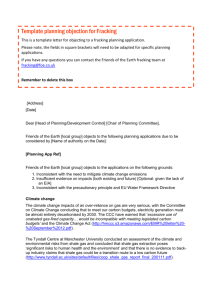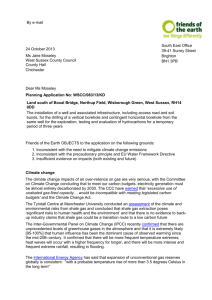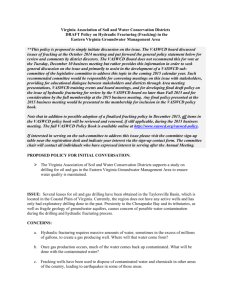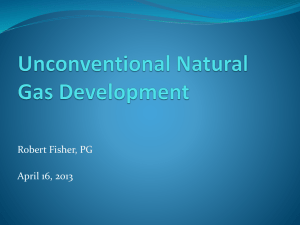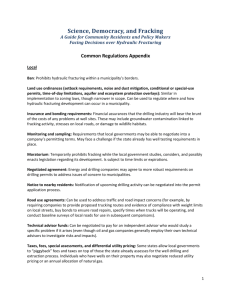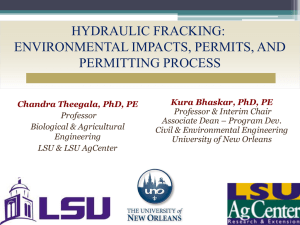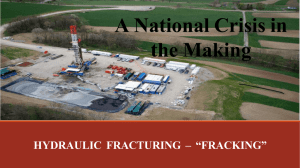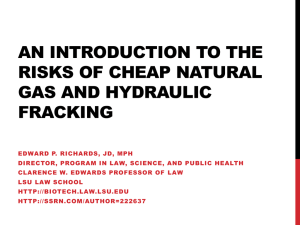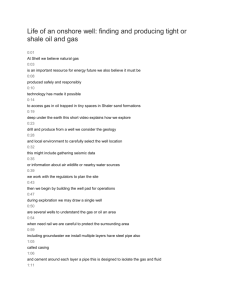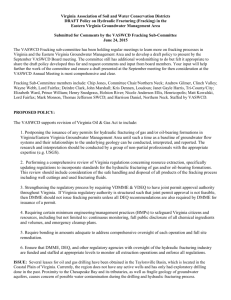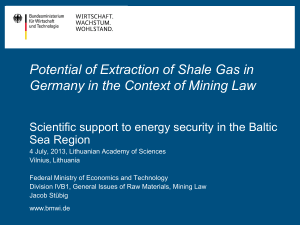Unacceptable adverse impacts and the Precautionary principle
advertisement
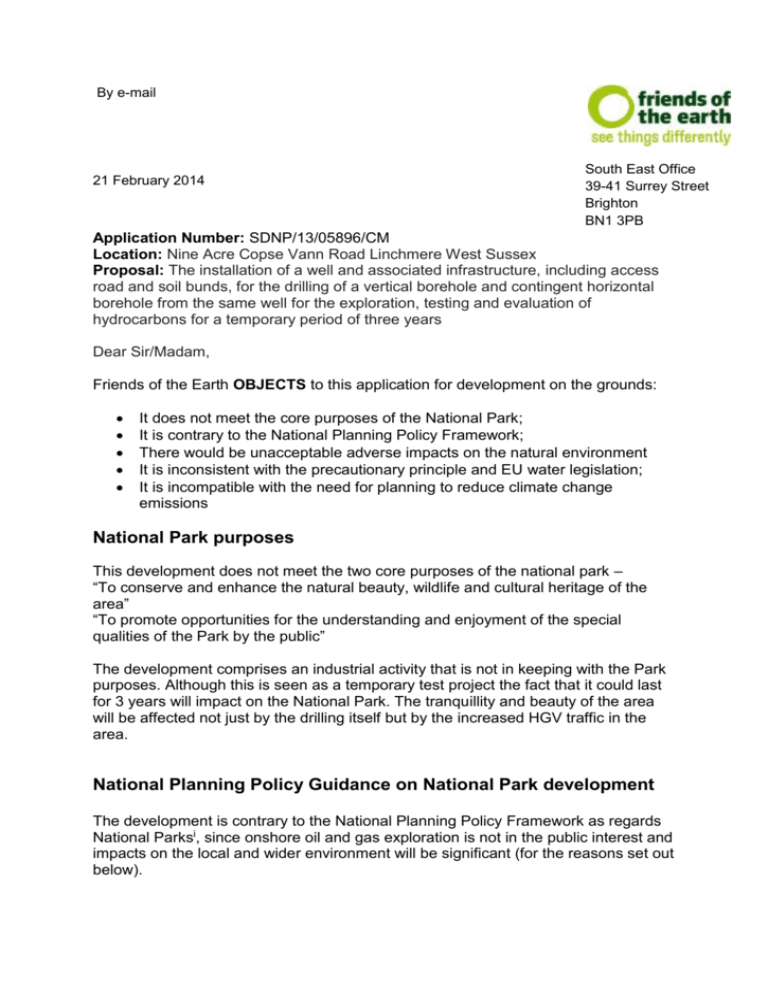
By e-mail 21 February 2014 South East Office 39-41 Surrey Street Brighton BN1 3PB Application Number: SDNP/13/05896/CM Location: Nine Acre Copse Vann Road Linchmere West Sussex Proposal: The installation of a well and associated infrastructure, including access road and soil bunds, for the drilling of a vertical borehole and contingent horizontal borehole from the same well for the exploration, testing and evaluation of hydrocarbons for a temporary period of three years Dear Sir/Madam, Friends of the Earth OBJECTS to this application for development on the grounds: It does not meet the core purposes of the National Park; It is contrary to the National Planning Policy Framework; There would be unacceptable adverse impacts on the natural environment It is inconsistent with the precautionary principle and EU water legislation; It is incompatible with the need for planning to reduce climate change emissions National Park purposes This development does not meet the two core purposes of the national park – “To conserve and enhance the natural beauty, wildlife and cultural heritage of the area” “To promote opportunities for the understanding and enjoyment of the special qualities of the Park by the public” The development comprises an industrial activity that is not in keeping with the Park purposes. Although this is seen as a temporary test project the fact that it could last for 3 years will impact on the National Park. The tranquillity and beauty of the area will be affected not just by the drilling itself but by the increased HGV traffic in the area. National Planning Policy Guidance on National Park development The development is contrary to the National Planning Policy Framework as regards National Parksi, since onshore oil and gas exploration is not in the public interest and impacts on the local and wider environment will be significant (for the reasons set out below). National Planning Policy Framework guidance on major developments in National Parks states: “ Planning permission should be refused for major developments in these designated areas except in exceptional circumstances and where it can be demonstrated they are in the public interest” The applicant has not demonstrated that this is an exceptional circumstance and the alternatives sites assessment report refers only to the PEDL 231 area when Celtique Energie have other licenses in West Sussex . Unacceptable adverse impacts and the Precautionary principle The precautionary principle is a principle at the heart of environmental law to which the UK Government has committed since it signed the Rio Declaration on Environment and Development in 1992. This states (at Principle 15) that, “where there are threats of serious or irreversible damage, lack of full scientific certainty shall not be used as a reason for postponing cost-effective measures to prevent environmental degradation”. Article 191(2) of the Treaty on the Functioning of the European Union declares that EU policy on the environment “shall be based on the precautionary principle”. We are concerned that the local authority with respect to this application is not applying a precautionary approach in a case with a high level of public interest. The precautionary principle finds specific expression through international and EU law instruments to which the UK is a signatory (and in the case of EU law, bound) including the Water Framework Directive, the Groundwater Directive and the Habitats Directive. The Water Framework Directive (and its daughter Directives, including Groundwater) applies strict standards and controls in relation in particular to groundwater. There is growing evidence in the UK and globally of the serious environmental impacts from hydraulic fracturing including to ecology, climate, water resources, air quality and seismic activity. The European Commission has identified water contamination, water resource depletion, air pollution, biodiversity impacts and noise as high risk concerns in its report ‘Support to the identification of potential risks for the environment and human health arising from hydrocarbons operations involving hydraulic fracturing in Europe’ August 2012 (http://ec.europa.eu/environment/integration/energy/pdf/fracking%20study.pdf). Whilst the company has not applied for permission to frack at the site, the activities it intends to carry out there are directly connected to fracking and may in fact be similar. For example, the use of chemicals in drilling muds and significant increases in truck movements. On these grounds, we believe that the local authority must take a precautionary approach and refuse the application on the basis of the risk of significant environmental impacts. Further, we believe the application is contrary to wider policy as regards mineral extraction on the basis that it may have “unacceptable adverse impacts” within the meaning of paragraph 143, National Planning Policy Framework for the reasons set out below.ii Paragraph 144 of the National Planning Policy Framework states that when determining planning applications, local planning authorities should "ensure in granting planning permission for mineral development, that there are no unacceptable adverse impacts on the natural and historic environment, human health [...]" We object on the grounds of the following unacceptable adverse impacts: Horizontal drilling We are concerned that the developer has applied to drill horizontally, but that insufficient information about this activity is given. There has been no assessment of the impact of horizontal drilling within the land. The application should not be decided until a full 3D geological survey has been undertaken, submitted and made available for public consultation. A 3D survey is arguably also required in order to adequately assess the hydrogeology of the strata which is important in order to assess water impacts (see water section below). The fact that the company wishes to drill horizontally, together with Information about the geology in the area, implies that should gas or oil be discovered it would lead to a need for hydraulic fracturing. Professor David Smythe - a Professor of Geophysics - has establishediii that due to the geology of the Sussex Weald Basin, any hydrocarbon extraction will need to make use of hydraulic fracturing. He has also pointed out that the area is prone to faults making it extremely difficult to judge any impacts of hydraulic fracturing. (Faults can provide pathways to groundwater for pollutants including methane). It is our view that if hydrocarbons could have been extracted conventionally this would have been done in the past, rather than using a more expensive and risky technology such as fracking. Given the uncertainty about the nature of the rock and the hydrogeological setting, we believe that the Authority must apply a precautionary approach which, in this case, would mean refusing the application. Proximity to housing The site is approximately 120 metres from the nearest property. This is too close. Nearby residents will be affected by noise, visual intrusion and disturbance from construction and ongoing operations. They will also be adversely affected by the increased traffic. Traffic The increase in HGV vehicles is detrimental to the first core purpose of the National Park. The type of rural roads in this area make this an unsuitable site. Noise and light It is unacceptable to have industrial drilling rigs working 24/7 in an area that is currently tranquil and rural. This is not in keeping with the village, nor the National Park status. Water and groundwater There is inadequate information about water use and impacts on water, particularly in terms of transport, extraction, pollution and potential leakage from the site. The area lies within a surface water safeguard zone and partially within a groundwater vulnerability zone. iv The impacts on wildlife and livestock from potential pollution do not appear to have been assessed. We are unclear on whether the drilling muds to be used will be oil based and whether any chemicals to be used have been disclosed. We note that the Environment Agency has requested that a “Risk Assessment to the Water Environment” is provided before any development takes place - to include: “An overall assessment of the impacts to groundwater from the drilling operation and use of drilling additives” It is our view that planning approval should not be given before the assessments requested by the Agency are completed and approved. Air Quality The application contains inadequate information about air quality impacts, in particular fugitive methane emissions, and the risks are therefore unknown. The “principle elements of the Proposed Development” summary at the beginning of the Project Description chapter makes no mention of erection of flares or venting equipment. Whilst this is described later in the document it is unclear what size of flare will be used. Paragraph 4.65 of the Project Description chapter mentions that the flare stack could “vent or flare” produced gas during the Extended Well testing phase. The Air Quality chapter states that “it is not possible to quantify the amount of gas (if any) that might need to be flared” but makes no mention of venting. Uncertainty about water and air impacts requires the planning authority to apply a precautionary approach. Venting is very harmful in carbon terms because methane is a vastly more powerful greenhouse gas than CO2v (Venting may also have significant air quality impacts). We are concerned that the Authority may struggle to grant planning permission which is legally robust if the impacts of these activities have not been fully evaluated and taken into account by the Authority. Landscape and visual impacts The scheme will have adverse impacts on the landscape and will affect views from public rights of way. This is incompatible with the purposes of the National Park. Wildlife and heritage impacts We are concerned that wildlife will be affected by the operations – particularly the lighting, noise and potential water pollution. The site is adjacent to ancient woodland and close to a Scheduled Ancient Monument. The impacts on these are not fully known. Monitoring Before conventional or unconventional drilling begins, it is essential to establish baseline levels of pollution at the site in order to be clear about the impact which exploratory activities will have. Baseline monitoring must be factored into the decision making process through environmental assessment and this is particularly important as regards air and water quality. The developer should be subject to planning conditions to ensure that it continues to monitor for example, air and water quality, at regular intervals throughout the period of the permission in order to rapidly identify any material deterioration in air or water quality. Climate change The extraction and use of shale gas will make it much harder to meet our legallybinding climate change targets. The South Downs National Park Authority has an important role to play in tackling climate change and national Planning guidance affirms that climate change is a core principle. The climate change impacts of an over-reliance on gas are very serious, with the Committee on Climate Change (CCC) concluding that to meet our carbon budgets, electricity generation must be almost entirely decarbonised by 2030. The CCC have warned that ‘excessive use of unabated gas-fired capacity… would be incompatible with meeting legislated carbon budgets’ and the Climate Change Act. vi The Tyndall Centre at Manchester University conducted an assessment of the climate and environmental risks from shale gas and concluded that shale gas extraction poses ‘significant risks to human health and the environment’ and that there is no evidence to back-up industry claims that shale gas could be a transition route to a low carbon future vii The latest Inter-Governmental Panel on Climate Change reportviii demonstrates that extreme weather is being caused now by climate change, and will in the future. This will lead to the occurrence of more frequent hot and fewer cold temperature extremes, heat waves with a higher frequency for longer and more intense and frequent extreme rainfall, resulting in flooding. The National Planning Policy Framework 2012 states in relation to climate change that it is a core planning principle (para 17): “support the transition to a low carbon future” and (para 93): “Planning plays a key role in helping shape places to secure radical reductions in greenhouse gas emissions…”. Whilst the carbon impact of a single shale gas well may be unlikely to breach carbon obligations of itself, it is essential (and in keeping with Annex II of the EIA Directive re. screening) that the planning authority undertakes a cumulative assessment of carbon impacts from developments in its area which include the impact of this application. This assessment should take account of all impacts arising out of the exploration for and development of the well included in the application, including from combustion by any means of the gas extracted. Local government must take its climate change obligations seriously and refuse damaging developments. Scope Whilst we note that the developer has committed not to undertake fracking, the scope of the application is nonetheless broad enough to encompass this technique (given the reference to “testing”). Since the impacts of fracking have not been assessed through EIA, we believe the scope of the planning permission (if granted) must explicitly exclude fracking to ensure that assessment of the impacts of this particular activity is undertaken and that the Authority maintains effective control and oversight of the use of the site. Conclusion The application to drill is contrary to the purposes of the National Park and the National Planning Policy Framework as regards the Parks. The application is at risk of breaching wider NPPF policy as regards minerals extraction and development because it may have “unacceptable adverse impacts”. The application contains inadequate information about a number of impacts meaning that a precautionary approach must be applied and the application should not be granted. Finally, the Authority must refuse this application on climate change grounds because of the carbon impacts of shale gas activities. Please keep us informed of progress of the application and the date at which the committee will make a decision. Yours sincerely, Brenda Pollack South East Campaigner On behalf of Friends of the Earth i NPPF Paragraph 116 https://www.gov.uk/government/publications/national-planning-policy-framework--2 iii Submission to House of Lords Economic Affairs Committee Nov 2013 http://www.davidsmythe.org/fracking/Smythe%20shale%20gas%20submission%20to%20HoL%20v1.5.pdf iv http://maps.environmentagency.gov.uk/wiyby/wiybyController?value=GU27+3NJ&lang=_e&ep=map&topic=drinkingwater&layerGroup s=default&scale=9&textonly=off&submit.x=0&submit.y=0#x=488407&y=128834&lg=1,2,&scale=9 v The US Environmental Protection Authority states: “Pound for pound, the comparative impact of CH4 on climate change is over 20 times greater than CO2 over a 100-year period” http://epa.gov/climatechange/ghgemissions/gases/ch4.html. vi http://hmccc.s3.amazonaws.com/EMR%20letter%20-%20September%2012.pdf vii http://www.tyndall.ac.uk/sites/default/files/coop_shale_gas_report_final_200111.pdf viii IPCC 5th Assessment Report – Climate Change 2013: the Physical Science Basis - Summary for Policy Makers http://www.climatechange2013.org/images/uploads/WGI_AR5_SPM_brochure.pdf
